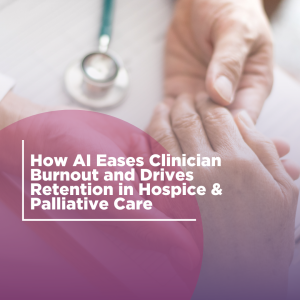AI Eases Clinician Burnout
by Curantis Solutions
AI in Hospice and Palliative Care
Eases Clinician Burnout and Drives Retention
In hospice and palliative care, clinicians are your most valuable and most vulnerable resource. They’re the heart of care delivery, and often the largest expense line item on your budget. But today, many are walking a tightrope between compassion fatigue and after-hours documentation burnout. Hospice organizations can’t afford to lose them. And with AI-powered tools, you don’t have to.
Clinician burnout Is a crisis and a cost center
Hospice nurses and interdisciplinary team members are burning out at unsustainable rates. The emotional weight of their work is immense, but it’s the after-hours charting, documentation delays, and system inefficiencies that often push them over the edge. The cost of clinician turnover is staggering. Onboarding and training a new hospice nurse takes time, money, and trust, and patients feel the impact, too.
AI bridges the gap without replacing the human touch
Curantis Solutions is leading the way with AI that lightens the load. Our embedded AI assistant, EVA, supports clinicians in real-time, reducing documentation friction and eliminating the need to chart late into the evening.
How AI may help
- Voice-to-text documentation
- captures patient-specific details naturally, as they happen
- Smart prompts and reminders
- prevent missed data points and reduce rework
- Less screen time after shifts
- improves work-life balance and job satisfaction
- Clinicians feel more supported and less likely to leave

Retain the staff you've worked so hard to hire
When your staff hears that another organization doesn’t have modern tech or AI tools? They stay. Providing intuitive, hospice-specific tools isn’t just about efficiency. It’s about creating a culture that respects their time, honors their energy, and values their expertise.
AI as a strategic investment in care and culture
Hospice leaders are being called to solve two problems at once:
- Deliver exceptional, person-centered care
- Do it with fewer resources and higher costs
AI-powered software like Curantis helps close this gap. By streamlining documentation and workflow, we help you preserve the well-being of your clinicians, which, in turn, protects your operations and your outcomes.
Imagine this...
- No more nurses charting late into the night
- Fewer resignations and higher morale
- Patients receiving care from clinicians who aren’t drained, but present and energized
# # #
Let's make clinician burnout a thing of the past
Explore how Curantis Solutions empowers your team and strengthens your bottom line. Contact us today to schedule a demo and see how we are making your software experience refreshingly simple with ChartBoost AI.
Contact us today to see a demo and learn how we are making your software experience refreshingly simple.
© 2025 This blog article originally appeared on the Curantis Solutions website and is reprinted with permission. For more information, please contact Curantis Solutions directly.






